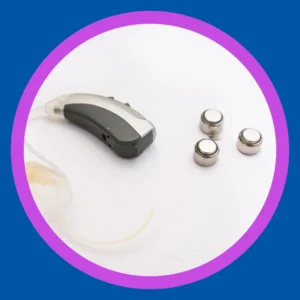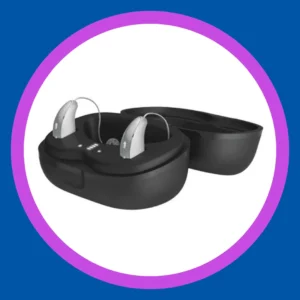Choosing a Hearing Aid Battery
Everything You Need to Know to Power Your Hearing Aids with Confidence
Your hearing aids rely on one vital component—your hearing aid battery. Without it, your hearing aids can’t function. Whether you use rechargeable or disposable batteries, the type, size, and quality of your battery greatly affect your hearing experience.
This guide will walk you through everything you need to know when choosing a hearing aid battery. We’ll also explore how to extend battery life, compare options, and offer tips for proper storage and maintenance.
Let’s dive into the essentials so you can make confident, informed decisions.
Understanding Hearing Aid Battery Types
Each hearing aid battery type functions differently. Choosing the right one depends on your lifestyle, preferences, and hearing aid model.

Zinc-Air (Disposable) Hearing Aid Batteries
Zinc-air batteries are the most common type of hearing aid battery available today. They power most standard hearing aids and come in color-coded sizes for easy identification.
How They Work:
Zinc-air batteries activate when exposed to air. Each battery has a protective sticker that covers tiny air holes. Once removed, oxygen enters and starts a chemical reaction to generate power.
Key Features of Zinc-Air Batteries:
- Lightweight and compact
- Available in multiple sizes
- Color-coded for easy recognition
- Consistent and reliable performance
Common Sizes and Color Codes:
Each battery size fits specific hearing aid models. Knowing the size helps you choose the right battery every time.
- Size 10 (Yellow): Used in small, discreet hearing aids like CIC (Completely-in-Canal)
- Size 312 (Brown): Used in RIC (Receiver-in-Canal) and Mini BTE hearing aids
- Size 13 (Orange): Used in BTE (Behind-the-Ear) and ITE (In-the-Ear) aids
- Size 675 (Blue): Used in high-power BTE hearing aids for profound hearing loss
Zinc-air batteries remain a dependable option for many users. Their availability and proven performance make them a popular choice.

Rechargeable Hearing Aid Batteries
Rechargeable batteries are a modern, convenient option growing in popularity. They eliminate the need for frequent battery replacements and reduce waste.
How They Work:
Rechargeable hearing aids typically use lithium-ion or nickel-metal hydride batteries. These batteries recharge overnight in a charging station.
Advantages of Rechargeable Batteries:
- Convenient daily charging
- Lower environmental impact
- Easier for individuals with dexterity challenges
- Long-term cost savings
Considerations:
- Requires consistent charging habits
- Not all hearing aids support rechargeable options
- May have a higher upfront cost
Rechargeable batteries simplify hearing aid use and support a sustainable lifestyle. They’re ideal for those who want less maintenance.
Key Factors When Choosing a Hearing Aid Battery
Selecting the right battery involves more than matching a size. Several important considerations impact performance and satisfaction.
1. Battery Compatibility
Each hearing aid requires a specific battery size. Check your hearing aid manual or consult your hearing care provider to confirm compatibility.
2. Lifestyle and Usage Habits
Think about how often and where you use your hearing aids.
- Frequent use may require longer-lasting batteries.
- If you regularly use Bluetooth, a rechargeable option may make more sense.
- Active lifestyles may benefit from rechargeable convenience.
- Travel routines may make disposable batteries more practical.
Explore more about the best Bluetooth hearing aids and traveling with hearing aids.
3. Budget and Cost Over Time
Consider both short-term and long-term costs.
- Disposable batteries require ongoing purchases.
- Rechargeable batteries offer long-term savings but higher initial investment.
4. Environmental Preferences
Environmentally conscious users may prefer rechargeable batteries. They reduce waste and eliminate the need for constant replacements.
5. Dexterity and Ease of Use
Small batteries can be difficult to handle. Rechargeable hearing aids may offer a better option for those with limited dexterity.
Weigh all factors to find the battery that meets your lifestyle, hearing needs, and values.
Discover the best hearing aids for noisy environments.
Where to Buy Hearing Aid Batteries
You can purchase batteries from several sources, but quality and freshness matter.
Reliable Places to Buy Hearing Aid Batteries:
- Pharmacies: Convenient and local
- Online Retailers: Offers variety and bulk options
- Hearing Care Providers: Trusted guidance and recommendations
Tips for Buying Batteries:
- Check expiration dates
- Store unopened packs in a dry place
- Buy from reputable suppliers to ensure quality
Buy your hearing aid batteries from trustworthy sources to ensure optimal performance and battery life.
How Long Should Hearing Aid Batteries Last?
Battery life varies depending on the size and type of battery, hearing aid model, and how often it’s used.
Typical Lifespans for Zinc-Air Batteries:
- Size 10 (Yellow): 3–7 days
- Size 312 (Brown): 3–10 days
- Size 13 (Orange): 6–14 days
- Size 675 (Blue): 9–20 days
Lifespans for Rechargeable Batteries:
- Lithium-Ion: 19–24 hours per charge
- Silver-Zinc: Around 24 hours per charge; yearly replacement may be needed
Battery life depends on many variables. Track your usage to plan replacements or charging cycles accordingly.
How to Maximize Hearing Aid Battery Life
Simple habits can significantly improve your battery’s performance and lifespan.
Tips for Zinc-Air Battery Users:
Before inserting your battery, try these tips:
- Wait Before Use:
After removing the tab, wait 5–7 minutes. This allows full activation. - Open Battery Door Overnight:
This prevents unnecessary drain and helps moisture evaporate. - Keep Batteries Clean and Dry:
Store in a dry area, and handle with clean hands to prevent oil transfer. - Avoid Metal Contact:
Don’t store batteries near keys or coins to prevent short-circuits. - Use Fresh Batteries:
Older batteries may not perform as well, even unopened.
Tips for Rechargeable Battery Users:
- Charge Nightly:
Consistent overnight charging ensures full power daily. - Avoid Full Discharge:
Recharge before batteries run completely out to prolong battery lifespan. - Clean Charging Contacts:
Keep both hearing aids and charger terminals clean for optimal charging. - Store in Charging Case:
Always place hearing aids in their charging case when not in use. - Avoid Overcharging:
Remove hearing aids once fully charged if your charger doesn’t auto-regulate.
Proper habits extend battery life and improve your hearing aid’s daily performance.
Find out more about hearing aid accessories.
Maintaining and Storing Your Hearing Aid Batteries
Battery care is just as important as battery choice. Proper storage and handling keep your batteries safe and effective.
Storage Tips for All Battery Types:
- Room Temperature is Best:
Store at 60–77°F. Extreme cold or heat shortens battery life. - Avoid Humid Environments:
Humidity can damage batteries. Don’t store them in kitchens or bathrooms. - Use the Original Packaging:
This protects batteries and prevents accidental activation. - Keep Batteries Separate from Metal Objects:
Avoid storing batteries near keys, coins, or other devices.
Cleaning and Maintenance Tips:
- Clean Battery Contacts Weekly:
Use a dry cloth or soft brush. Remove any dust or debris. - Check for Corrosion:
Inspect the battery compartment regularly. Clean buildup gently if needed. - Handle With Dry Hands:
Moisture or oils from fingers can affect performance.
Proper storage and maintenance improve safety and extend battery usability.
How to Replace a Hearing Aid Battery
Changing a hearing aid battery is simple when done correctly.
Step-by-Step Battery Replacement Process:
- Gather Supplies:
You’ll need fresh batteries, a cleaning brush, and a dry cloth. - Remove the Old Battery:
Open the battery door gently. Let the old battery fall out or remove it carefully. - Activate the New Battery:
Peel the tab and wait 5–7 minutes before inserting. - Insert Battery Correctly:
Match the “+” side of the battery with the correct orientation. - Close the Battery Door:
Snap the door shut gently. Don’t force it closed. - Test the Hearing Aid:
Turn it on. If it doesn’t work, double-check the placement.
Practice makes battery changes easy. Follow these steps for reliable hearing aid function.
Safety Tips for Hearing Aid Battery Use
Batteries are powerful but must be handled safely.
Important Safety Guidelines:
- Keep Batteries Away from Children and Pets: Accidental swallowing is dangerous.
- Seek Immediate Help if Swallowed: Contact poison control or a medical provider.
- Never Insert Batteries into Ears or Nose: This can cause serious injury.
- Use Only Hearing Aid Batteries: Don’t try batteries in other devices.
Stay safe by following simple precautions when storing and handling hearing aid batteries.
Troubleshooting Common Battery Issues
Battery problems can affect hearing aid performance. Knowing what to check can save time.
Quick Troubleshooting Tips:
- Device Not Turning On?
- Check orientation and battery freshness
- Clean the contacts and battery compartment
- Short Battery Life?
- Turn off high-drain features
- Check for corrosion
- Store batteries correctly
- Still Having Issues?
- Contact your hearing care provider for a battery or device inspection
Addressing battery issues promptly prevents further hearing aid problems.

Still Have Questions? Contact Stanford Hearing Today
Choosing the right hearing aid battery improves daily hearing performance and long-term satisfaction.
Whether you need help finding the correct size, want to switch to rechargeable, or need tips on storage—Stanford Hearing is here to help.
Call us today or schedule an appointment.
Let our friendly hearing care providers guide you toward better hearing, one battery at a time.
